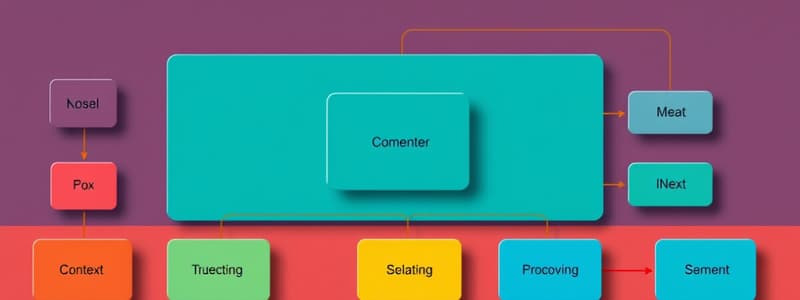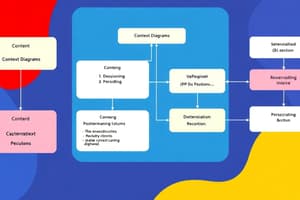Podcast
Questions and Answers
What is the purpose of a System Context diagram?
What is the purpose of a System Context diagram?
To show the big picture of a software system, including users and other systems it interacts with.
What does a Container diagram illustrate?
What does a Container diagram illustrate?
The high-level shape of the software architecture and how responsibilities are distributed across containers.
What is shown in a Component diagram?
What is shown in a Component diagram?
The structure of a container made up of components, their responsibilities, and technology details.
What is a Code diagram used for?
What is a Code diagram used for?
Which of the following are examples of design concepts? (Select all that apply)
Which of the following are examples of design concepts? (Select all that apply)
A design must only implement explicit requirements of the analysis model.
A design must only implement explicit requirements of the analysis model.
What should quality guidelines for design ensure?
What should quality guidelines for design ensure?
A design should contain distinct representations of ______, architecture, interfaces, and components.
A design should contain distinct representations of ______, architecture, interfaces, and components.
What is the primary purpose of using user stories in an architectural model?
What is the primary purpose of using user stories in an architectural model?
Which of the following elements is NOT part of the architectural styles description?
Which of the following elements is NOT part of the architectural styles description?
How is control managed within an architecture according to the given criteria?
How is control managed within an architecture according to the given criteria?
What type of architectural model emphasizes the flow of data between components?
What type of architectural model emphasizes the flow of data between components?
During a sprint, what is a crucial task the architect must perform after the prototype is developed?
During a sprint, what is a crucial task the architect must perform after the prototype is developed?
What is the primary goal of task analysis in UX design?
What is the primary goal of task analysis in UX design?
In the sketch phase of a Google UX Design Sprint, what is the objective?
In the sketch phase of a Google UX Design Sprint, what is the objective?
What occurs during the validate phase of the UX design process?
What occurs during the validate phase of the UX design process?
Which of the following is NOT a question addressed in task analysis?
Which of the following is NOT a question addressed in task analysis?
During the decide phase of the Google UX Design Sprint, what is the primary method used to select solutions?
During the decide phase of the Google UX Design Sprint, what is the primary method used to select solutions?
Flashcards are hidden until you start studying
Study Notes
Software Architecture Overview
- C4 Model: A framework focusing on four perspectives: Context, Containers, Components, and Code.
- A System Context diagram provides a high-level view of a software system, emphasizing interactions between users, actors, and other systems, rather than technical details.
- Container diagrams zoom in on the system, illustrating runnable units (like applications, databases) and how they communicate. Useful for developers and operations teams.
- Component diagrams break down containers into structural elements, defining individual components and their responsibilities along with technology details.
- Code diagrams detail the implementation of components, often generated automatically, and are primarily used for complex components.
Software Design Principles
- Software design incorporates principles and practices to ensure high-quality system development.
- Design principles guide the creation process and must be grasped before applying design mechanics.
- Continuous evolution of design practices occurs with advancements in methods, analysis, and understanding.
Key Design Concepts
- Data/Class Design: Converts analysis classes into implementation classes and structures.
- Architectural Design: Establishes relationships among main structural software elements.
- Interface Design: Defines interaction modes between software, hardware, and end-users.
- Component-level Design: Translates structural elements into procedural software component descriptions.
Design and Quality Considerations
- Designs must satisfy all explicit requirements from the analysis model and support implicit customer desires.
- The design should be clear and informative for coding, testing, and maintenance teams.
- Comprehensive designs address data, functional, and behavioral domains from an implementation standpoint.
Quality Guidelines
- Designs should manifest recognizable architectural styles and be composed of well-structured components, evolving over time.
- Modularity is essential for effective design.
- Designs should have clear representations of data, architecture, interfaces, and components.
- Data structures should emerge from established data patterns.
- Functional independence of components is crucial to maintain a coherent design.
Decision Documentation and Communication
- Document all decisions promptly to maintain clarity and traceability throughout the project.
Agility and Architecture
- User stories are essential for creating and evolving an architectural model, termed a walking skeleton.
- Architects collaborate with product owners to incorporate user stories into the storyboard and prioritize them for sprints.
- Architectural documentation should be delivered during each sprint, ensuring continuous integration with development.
- Post-sprint, architects evaluate the prototype for quality before presenting to stakeholders.
Architectural Styles
- Each architectural style encompasses:
- A set of components (e.g., databases, computational modules) fulfilling specific functions.
- Connectors for communication and coordination among components.
- Constraints governing the integration of components.
- Semantic models aiding designers in understanding the system's properties.
Architectural Organization
- Control management within architecture considers:
- Existence of a control hierarchy and component roles.
- Mechanisms for control transfer and sharing among components.
- Control topology and its synchronization status (synchronous vs. asynchronous).
Task Analysis
- Task analysis aims to clarify:
- User work in specific scenarios.
- Sequence of tasks and subtasks, defining workflows.
- Object manipulation in problem domains.
Google 5-Day UX Design Sprint
- Understand: Conduct user research to align software needs and business objectives; utilize whiteboards for reference.
- Sketch: Stakeholders create paper sketches to brainstorm and generate ideas quickly.
- Decide: Teams vote on sketches to select solutions for prototyping, considering assumptions if consensus isn't reached.
- Prototype: Develop minimally viable products or components based on selected sketches, using user stories for test cases.
- Validate: Engage users with prototypes to capture feedback and identify UX issues for immediate iteration.
Interface Design Principles
- Interfaces should minimize learning and relearning time, using appropriate metaphors for ease of use.
- Readability is crucial for all age groups; store user interaction state to enhance usability.
- Visible navigation should give users a sense of place and accessibility.
Accessibility Guidelines
- Ensure interface designs support users with special needs and maintain consistent response times.
- Provide comprehensive online help and constructive error handling.
- Menu options should match standard command labels and enable easy internationalization.
Mobile Development Challenges
- Mobile applications vary in user experience; different users have different expectations for functionality.
- Design must leverage device-specific capabilities while addressing testing complexities and performance constraints.
Mobile Development Life Cycle
- Inception: Define goals and features.
- Design: Create user experience through mockups and prototypes.
- Development: Code and conduct usability testing.
- Stabilization: Progress through prototypes (feasibility, alpha, beta) to a release candidate.
- Deployment: Review app store submissions for public release.
Mobile User Interface Design Models
- Platform models focus on constraints; presentation models define interface appearance; task models outline user tasks.
Mobile User Interface Evaluation
- Assess device readiness based on UI consistency, interoperability, and acceptance of stakeholder values.
Mobile Design Approaches
- Usage scenarios must account for context variables.
- Ethnographic observation informs design without interference.
- Low-fidelity prototypes (e.g., paper) allow usability testing before implementation.
Mobile Design Mistakes
- Avoid feature overload; maintain consistency in UI elements for a uniform experience.
- Prioritize speed to prevent user frustration; avoid lengthy text in menus.
- Use standard interaction mechanics; online help cannot substitute for good design.
Services Computing
- Focuses on architectural design via service discovery and composition, enabling mobile app developers to avoid integrating service source code directly.
Studying That Suits You
Use AI to generate personalized quizzes and flashcards to suit your learning preferences.




